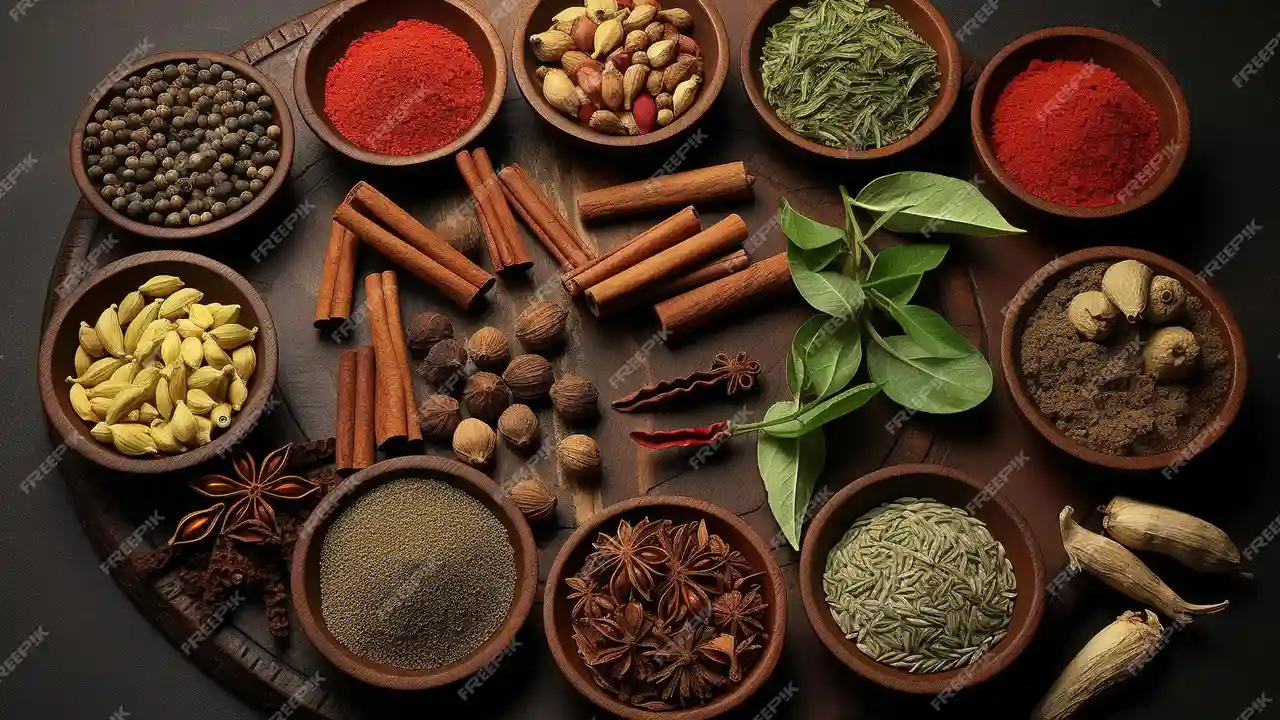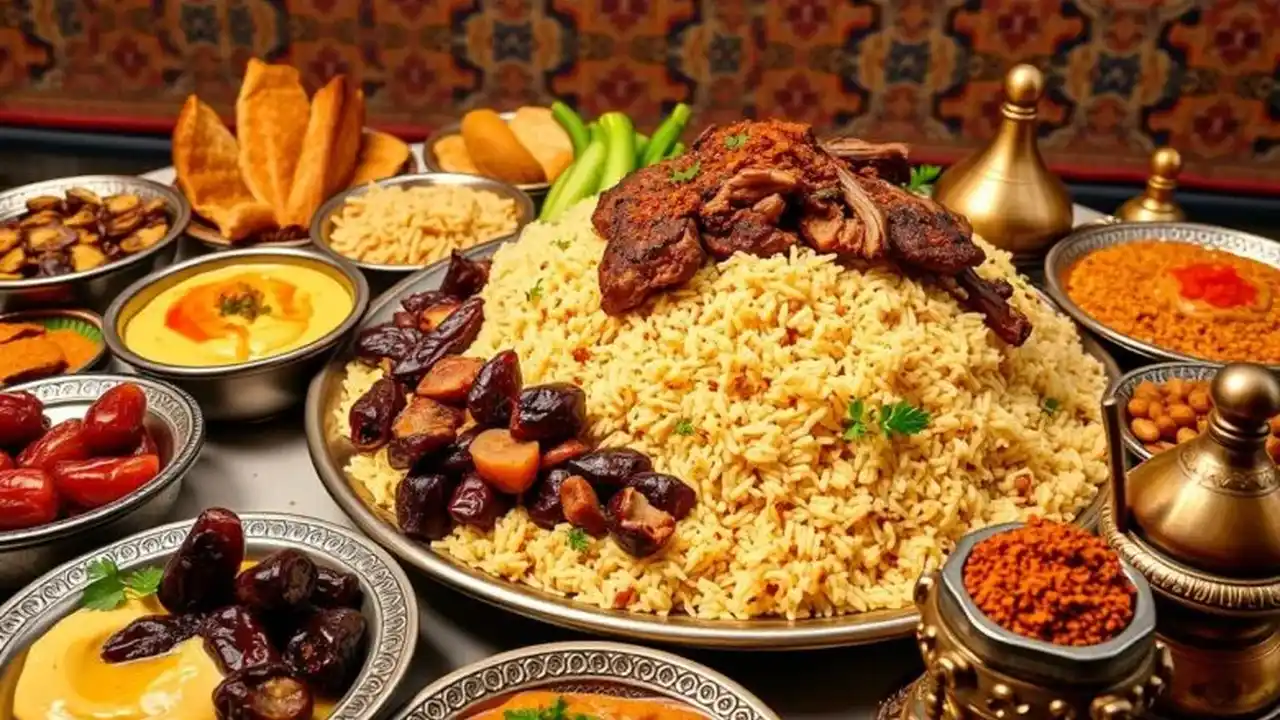
Saudi Arabian Cuisine An Introduction
Saudi Arabian cuisine is a tapestry woven with threads of tradition, history, and the diverse landscapes of the Arabian Peninsula. From the bustling spice markets to the nomadic Bedouin traditions, the food reflects the soul of the nation. This article delves into the heart of Saudi Arabian culinary delights, exploring the ingredients, dishes, and customs that make it unique.
Staple Ingredients in Saudi Arabian Cooking
The foundation of Saudi Arabian cuisine rests on a few key ingredients. Rice, often long-grain basmati, is a cornerstone, served with almost every meal. Dates, a symbol of hospitality and sustenance, are abundant and come in countless varieties. Lamb and chicken are the most commonly consumed meats, while seafood is prevalent in coastal regions. Spices, of course, play a vital role, adding depth and complexity to every dish.
Let's explore some of these key ingredients in more detail:
- Rice: Basmati rice is preferred for its fragrant aroma and fluffy texture. It's often cooked with spices, nuts, and dried fruits.
- Dates: From the soft and chewy Ajwa to the sweet and caramel-like Medjool, dates are a national treasure. They're eaten plain, stuffed, or used in desserts.
- Lamb and Chicken: These meats are usually grilled, roasted, or cooked in stews. They're often marinated in spices and yogurt for added flavor.
- Spices: Cumin, coriander, cardamom, cinnamon, cloves, turmeric, and saffron are just a few of the spices that flavor Saudi Arabian cuisine. Each spice adds a unique layer of complexity.
- Yogurt and Laban: Yogurt is a staple, used in marinades, sauces, and as a refreshing drink. Laban, a fermented milk drink, is particularly popular during hot weather.
Traditional Saudi Arabian Dishes A Deep Dive
Now, let's journey into some of the most iconic dishes that define Saudi Arabian cuisine:
Kabsa The National Dish of Saudi Arabia
Kabsa is arguably the national dish of Saudi Arabia. It's a fragrant rice dish cooked with meat (usually chicken or lamb), vegetables, and a blend of spices. The rice is typically cooked in the same pot as the meat, absorbing all the delicious flavors. Variations abound, with different regions adding their own unique twists.
Ingredients Typically Found in Kabsa:
- Basmati rice
- Chicken or lamb
- Tomatoes
- Onions
- Garlic
- Bell peppers
- Carrots
- Raisins
- Almonds
- Kabsa spice mix (a blend of cumin, coriander, cardamom, cinnamon, cloves, black pepper, and turmeric)
How to Make Kabsa:
- Sauté onions and garlic in oil until softened.
- Add the meat and brown on all sides.
- Add tomatoes, bell peppers, carrots, and Kabsa spice mix.
- Cook for a few minutes, then add water or broth.
- Bring to a boil, then reduce heat and simmer until the meat is tender.
- Add the rice and cook until the rice is cooked through and the liquid is absorbed.
- Garnish with raisins and almonds.
Mandi A Flavorful Meat and Rice Dish
Mandi is another popular rice dish, particularly in the southern regions of Saudi Arabia. It's traditionally cooked in a underground oven called a "tandoor" or "mandi oven," which imparts a unique smoky flavor to the meat. The meat is usually lamb or chicken, and it's cooked until it's incredibly tender and falls off the bone.
Key Characteristics of Mandi:
- Smoky flavor due to the cooking method.
- Extremely tender meat.
- Often served with a spicy tomato-based sauce (sahawiq).
Mandi vs. Kabsa: What's the Difference?
While both are rice-based dishes with meat, Mandi and Kabsa differ in their cooking methods and flavor profiles. Mandi has a distinctive smoky flavor due to the underground oven, while Kabsa is typically cooked in a pot on the stovetop. Kabsa also tends to be spicier and more flavorful due to the use of a wider range of spices.
Jareesh A Hearty Wheat Porridge
Jareesh is a traditional Saudi Arabian dish made from coarsely ground wheat, cooked with meat (usually lamb or chicken) and milk or yogurt. It's a hearty and comforting dish, often served during special occasions or in the winter months.
Variations of Jareesh:
Jareesh recipes vary from region to region. Some variations include the addition of vegetables like onions, carrots, and tomatoes. Others may use different types of meat or different types of dairy products.
Saleeg A Creamy Rice Porridge
Saleeg is a creamy rice porridge cooked with milk or cream and chicken. It's a simple yet elegant dish, often served at weddings and other celebrations. The rice is cooked until it's very soft and creamy, almost like a risotto.
Tips for Making Perfect Saleeg:
- Use high-quality short-grain rice.
- Cook the rice slowly over low heat.
- Stir the rice frequently to prevent it from sticking to the bottom of the pot.
- Add milk or cream gradually, stirring until it's fully absorbed.
Mutabbaq A Savory Stuffed Pancake
Mutabbaq is a popular street food in Saudi Arabia. It's a savory stuffed pancake filled with meat (usually ground beef or lamb), vegetables, and eggs. The pancake is cooked on a griddle until it's golden brown and crispy.
Different Fillings for Mutabbaq:
While meat is the most common filling, Mutabbaq can also be filled with cheese, vegetables, or a combination of both.
Tharid A Bread and Meat Stew
Tharid is a traditional Bedouin dish consisting of pieces of bread soaked in a meat stew. It's a simple and nourishing dish, perfect for a cold desert night. The bread is usually day-old bread, and the stew is typically made with lamb or chicken and vegetables.
The Significance of Tharid in Bedouin Culture:
Tharid is a symbol of hospitality and sharing in Bedouin culture. It's often served to guests as a sign of welcome.
Saudi Arabian Drinks Refreshments and Beverages
Beyond the delicious food, Saudi Arabia offers a variety of refreshing drinks to quench your thirst:
Qahwa Saudi Coffee A Symbol of Hospitality
Qahwa, or Saudi coffee, is more than just a drink; it's a cultural ritual. It's typically made with lightly roasted Arabica coffee beans, flavored with cardamom, and served in small, ornate cups. The serving of Qahwa is a sign of hospitality and respect.
The Etiquette of Drinking Qahwa:
- Accept the cup with your right hand.
- Drink the coffee slowly and savor the flavor.
- Shake the cup gently to indicate that you've had enough.
Laban A Refreshing Yogurt Drink
Laban is a fermented milk drink, similar to yogurt but thinner and saltier. It's a popular drink, especially during the hot summer months, as it's believed to have cooling properties.
Health Benefits of Laban:
Laban is a good source of probiotics, which are beneficial for gut health. It's also a good source of calcium and protein.
Saudi Champagne A Non Alcoholic Sparkling Drink
Saudi Champagne is a popular non-alcoholic sparkling drink made with apple juice, sparkling water, and fruits like apples, oranges, and strawberries. It's a refreshing and festive drink, often served at celebrations and gatherings.
Variations of Saudi Champagne:
Some variations of Saudi Champagne include the addition of mint leaves or other herbs for added flavor.
Tamar Hindi A Tangy Tamarind Drink
Tamar Hindi is a tangy drink made from tamarind pulp, water, and sugar. It's a refreshing and thirst-quenching drink, particularly popular during Ramadan.
Nutritional Value of Tamar Hindi:
Tamar Hindi is a good source of vitamin C and antioxidants.
Saudi Arabian Desserts Sweet Endings
No culinary journey is complete without exploring the desserts. Saudi Arabian sweets are often rich, decadent, and infused with the flavors of dates, nuts, and spices.
Maamoul Stuffed Cookies
Maamoul are small, buttery cookies filled with dates, pistachios, or walnuts. They're often decorated with intricate patterns and are a popular treat during Eid.
Tips for Making Perfect Maamoul:
- Use high-quality butter.
- Don't overmix the dough.
- Chill the dough before shaping the cookies.
Umm Ali Bread Pudding
Umm Ali is a popular dessert throughout the Middle East, including Saudi Arabia. It's a creamy bread pudding made with bread, milk, nuts, raisins, and spices. It's typically baked until golden brown and bubbly.
The Legend Behind Umm Ali:
The legend says that Umm Ali was a woman who created this dessert to celebrate her victory over her husband's first wife.
Luqaimat Fried Dough Balls
Luqaimat are small, crispy fried dough balls drizzled with date syrup or honey. They're a popular street food and a sweet treat enjoyed throughout the year.
How to Make Luqaimat Crispy:
To make Luqaimat crispy, fry them in hot oil and don't overcrowd the pan.
Kunafa Cheese Pastry
Kunafa is a popular Middle Eastern dessert made with shredded phyllo dough, cheese, and syrup. The cheese is typically a soft, unsalted cheese like akkawi or nabulsi. The phyllo dough is soaked in melted butter and then baked until golden brown and crispy. Finally, it's drizzled with a sweet syrup flavored with rose water or orange blossom water.
Variations of Kunafa:
Kunafa can be made with different types of cheese and different types of nuts. Some variations also include the addition of cream or custard.
Saudi Arabia Food Culture and Customs Dining Etiquette
Understanding the food culture and customs is essential when dining in Saudi Arabia. Here are a few key points to keep in mind:
- Right Hand Only: Always eat with your right hand, as the left hand is considered unclean.
- Sharing is Caring: Food is often served family-style, with dishes placed in the center of the table for everyone to share.
- Hospitality: Accepting food and drink offered to you is considered polite.
- Respect for Elders: Elders are typically served first.
- No Waste: While it's okay to leave a small amount of food on your plate, avoid wasting large amounts of food.
Exploring Saudi Arabia Spice Markets A Sensory Experience for Foodies
The spice markets of Saudi Arabia are a feast for the senses. The vibrant colors, exotic aromas, and bustling atmosphere create an unforgettable experience for foodies and travelers alike. Here, you can find a wide array of spices, herbs, dried fruits, nuts, and other culinary treasures.
Popular Spices to Buy in Saudi Arabia:
- Saffron
- Cardamom
- Cumin
- Coriander
- Cinnamon
- Cloves
- Turmeric
- Black Pepper
Saudi Arabian Food Tourism A Growing Trend
Food tourism in Saudi Arabia is on the rise, as more and more travelers are seeking authentic culinary experiences. From traditional restaurants to street food stalls, there's something for every palate. The Saudi government is also investing in promoting food tourism, with initiatives like culinary festivals and cooking classes.
Recommended Saudi Arabian Food Products and Their Uses
Here are some recommended Saudi Arabian food products and their uses:
Al-Watania Dates Premium Quality Dates from Saudi Arabia
Al-Watania is a well-known brand in Saudi Arabia for producing high-quality dates. They offer a wide variety of dates, including Ajwa, Medjool, and Sukkari. These dates are perfect for eating plain, stuffing, or using in desserts.
Pricing: Al-Watania dates range in price depending on the variety and quality. A kilogram of Medjool dates can cost around $20-$30.
Uses:
- Eating plain as a healthy snack
- Stuffing with nuts or cheese
- Using in desserts like Maamoul or date cakes
- Adding to smoothies or oatmeal
Sadia Chicken Halal Certified Chicken Products
Sadia is a popular brand for halal-certified chicken products in Saudi Arabia. Their chicken is known for its quality and freshness. It can be used in a variety of dishes, including Kabsa, Mandi, and grilled chicken.
Pricing: Sadia chicken is competitively priced, with a whole chicken costing around $5-$7.
Uses:
- Making Kabsa or Mandi
- Grilling or roasting
- Using in chicken stews or soups
- Adding to salads or sandwiches
Almarai Dairy Products Fresh and Delicious
Almarai is a leading dairy company in Saudi Arabia, offering a wide range of fresh and delicious dairy products, including milk, yogurt, and cheese. Their products are essential for many Saudi Arabian dishes and beverages.
Pricing: Almarai dairy products are affordable and widely available. A liter of milk costs around $1-$2.
Uses:
- Drinking plain or adding to coffee or tea
- Using in yogurt-based dishes like Laban or Jareesh
- Using cheese in Mutabbaq or Kunafa
Nadec Juices and Drinks A Variety of Refreshing Options
Nadec offers a wide range of juices and drinks, including Saudi Champagne and Tamar Hindi. Their products are known for their quality and refreshing taste. They are perfect for quenching your thirst on a hot day.
Pricing: Nadec juices and drinks are reasonably priced, with a bottle costing around $2-$3.
Uses:
- Drinking as a refreshing beverage
- Serving at celebrations and gatherings
- Using as a mixer for cocktails (non-alcoholic)
Comparing Saudi Arabian Food Products Brands and Quality
When choosing Saudi Arabian food products, it's important to consider the brand, quality, and price. Here's a comparison of some popular brands:
| Product | Brand | Quality | Price |
|---|---|---|---|
| Dates | Al-Watania | Premium | High |
| Dates | Bateel | Luxury | Very High |
| Chicken | Sadia | Good | Medium |
| Chicken | Tanmiah | Good | Medium |
| Dairy | Almarai | Good | Medium |
| Dairy | Nada | Good | Medium |
| Juices | Nadec | Good | Medium |
| Juices | Al Rabie | Good | Medium |
The Future of Food and Drink in Saudi Arabia Innovation and Trends
The food and drink scene in Saudi Arabia is constantly evolving. With a growing population and a rising interest in international cuisine, there's a demand for innovation and new trends. Some of the key trends include:
- Increased focus on healthy eating: More and more people are seeking healthier food options, such as organic produce and low-fat dishes.
- Growing popularity of international cuisine: Restaurants offering cuisines from around the world are becoming increasingly popular.
- Rise of food delivery services: Food delivery services are making it easier for people to enjoy their favorite meals at home.
- Emphasis on sustainability: There's a growing awareness of the importance of sustainable food practices.
Saudi Arabian cuisine is a vibrant and diverse culinary landscape that reflects the rich history and culture of the nation. From the iconic Kabsa to the refreshing Qahwa, there's something to tantalize every taste bud. By understanding the ingredients, dishes, and customs, you can embark on a truly unforgettable culinary journey through Saudi Arabia.
:max_bytes(150000):strip_icc()/277019-baked-pork-chops-with-cream-of-mushroom-soup-DDMFS-beauty-4x3-BG-7505-5762b731cf30447d9cbbbbbf387beafa.jpg)






